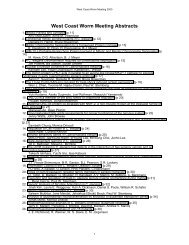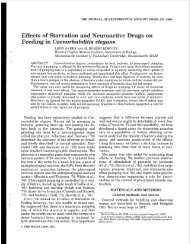Program of the 2004 East Coast Worm Meeting - Caenorhabditis ...
Program of the 2004 East Coast Worm Meeting - Caenorhabditis ...
Program of the 2004 East Coast Worm Meeting - Caenorhabditis ...
You also want an ePaper? Increase the reach of your titles
YUMPU automatically turns print PDFs into web optimized ePapers that Google loves.
1. Candidate EGO-1 interactors that function in germline development.<br />
Xiang Yu 1 , Valarie Vought 1 , Jamie Wasilenko 1 , Tom Ratliff 2 , Bill Kelly 2 , Eleanor Maine 1<br />
1Department <strong>of</strong> Biology, Syracuse University, Syracuse, NY<br />
2Biology Department, Emory University, Atlanta, GA<br />
ego-1 was identified in a genetic screen for enhancers <strong>of</strong> glp-1 (Qiao et al.1995). Later studies<br />
showed that ego-1 mutants have defects in germline proliferation, meiotic progression,<br />
gametogenesis and RNA interference (RNAi) (Smardon et al. 2000). EGO-1 belongs to <strong>the</strong><br />
RNA-dependent RNA Polymerase (RdRP) family. RdRP family members have been shown to<br />
function in RNA silencing in many organisms, although <strong>the</strong>ir specific role is unclear. Our working<br />
model is that <strong>the</strong> ego-1 developmental defects result from defects in RNA metabolism, perhaps<br />
specifically from <strong>the</strong> failure to produce or amplify small, non-coding RNA important for various<br />
cellular processes. Two approaches that we have taken to understanding <strong>the</strong> role <strong>of</strong> EGO-1 in<br />
germline development are to screen for interaction partners using <strong>the</strong> yeast two-hybrid system<br />
and to investigate chromatin structure in ego-1 mutant germ lines.<br />
EGO-1 is predicted to be a 1632 amino acid (aa) protein with a conserved RdRP domain (813<br />
aa) located between N-terminal (491 aa) and C-terminal (328 aa) domains. We used both<br />
N-terminal and C-terminal domains as "bait" in two-hybrid screens. We <strong>the</strong>n tested candidate<br />
interactors by RNAi to identify those that function in <strong>the</strong> germ line, and particularly those whose<br />
germline function might be related to ego-1. We identified three genes that bind <strong>the</strong> EGO-1<br />
N-terminal domain and have severe proliferation defects in RNAi injection experiments. We <strong>the</strong>n<br />
used tempered RNAi to produce milder proliferation defects, and checked for genetic interactions<br />
with glp-1. We find that R08C7.12 RNAi causes a meiotic progression defect similar to ego-1<br />
mutants, but does not enhance glp-1(ts). In contrast, ZC518.2 RNAi causes a masculinized germ<br />
line (a Mog defect) in wildtype animals and enhances glp-1(ts). Finally, <strong>the</strong> Y54F10BM.2 RNAi<br />
proliferation defect is more severe in a glp-1(ts) background than in a wildtype background,<br />
suggesting that it is enhanced by glp-1(ts). We are now extending <strong>the</strong>se RNAi studies to include<br />
o<strong>the</strong>r relevant genes, and are collaborating with <strong>the</strong> Conradt lab (Dartmouth College) to recover<br />
deletion alleles <strong>of</strong> all three genes. To complement <strong>the</strong>se studies, we are using a directed yeast<br />
two-hybrid approach to better define <strong>the</strong> physical interactions between EGO-1 and <strong>the</strong>se three<br />
proteins.<br />
Studies in S. pombe have shown that chromatin silencing modifications depend, at least in part,<br />
on components <strong>of</strong> <strong>the</strong> RNAi machinery, including <strong>the</strong> pombe RdRP, RdP1 (Volpe et al., 2002).<br />
For example, accumulation <strong>of</strong> a silencing modification on centromeres, methylation <strong>of</strong> histone H3<br />
on <strong>the</strong> lysine 9 residue (H3meK9), is defective in RdP1 mutants. In <strong>the</strong> C. elegans germ line,<br />
H3meK9 silencing modifications accumulate on <strong>the</strong> X chromosome during male meiosis and on<br />
o<strong>the</strong>r unpaired DNA (Bean et al., <strong>2004</strong>). We are investigating whe<strong>the</strong>r EGO-1 function is<br />
important for this aspect <strong>of</strong> germline chromatin assembly. Preliminary data suggest that silencing<br />
modifications on <strong>the</strong> male X are dependent on EGO-1 function.<br />
Bean et al. (<strong>2004</strong>) Nature Genetics 36, 100-105<br />
Qiao et al. (1995) Genetics 141, 551-569<br />
Smardon et al. (2000) Current Biology 10, 169-178<br />
Volpe et al. (2002) Science 297, 1833-1837.




